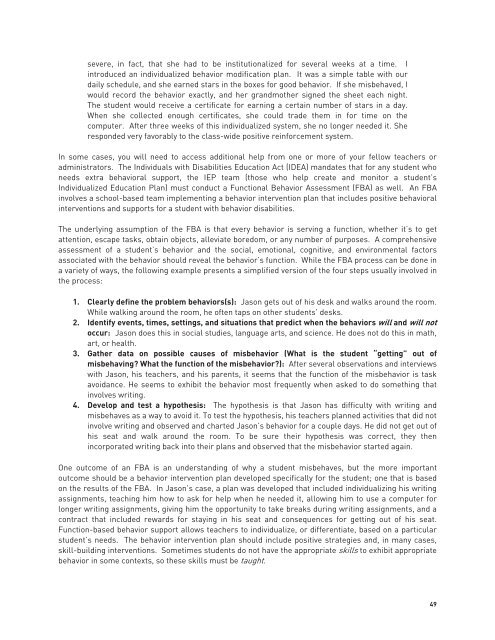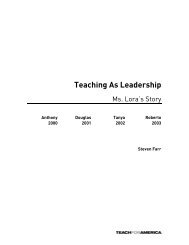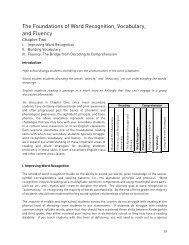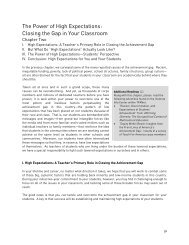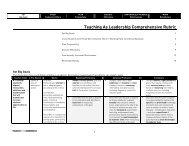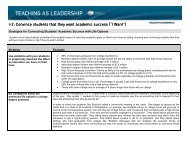Responding to Misbehavior - Teaching As Leadership
Responding to Misbehavior - Teaching As Leadership
Responding to Misbehavior - Teaching As Leadership
Create successful ePaper yourself
Turn your PDF publications into a flip-book with our unique Google optimized e-Paper software.
severe, in fact, that she had <strong>to</strong> be institutionalized for several weeks at a time. I<br />
introduced an individualized behavior modification plan. It was a simple table with our<br />
daily schedule, and she earned stars in the boxes for good behavior. If she misbehaved, I<br />
would record the behavior exactly, and her grandmother signed the sheet each night.<br />
The student would receive a certificate for earning a certain number of stars in a day.<br />
When she collected enough certificates, she could trade them in for time on the<br />
computer. After three weeks of this individualized system, she no longer needed it. She<br />
responded very favorably <strong>to</strong> the class-wide positive reinforcement system.<br />
In some cases, you will need <strong>to</strong> access additional help from one or more of your fellow teachers or<br />
administra<strong>to</strong>rs. The Individuals with Disabilities Education Act (IDEA) mandates that for any student who<br />
needs extra behavioral support, the IEP team (those who help create and moni<strong>to</strong>r a student’s<br />
Individualized Education Plan) must conduct a Functional Behavior <strong>As</strong>sessment (FBA) as well. An FBA<br />
involves a school-based team implementing a behavior intervention plan that includes positive behavioral<br />
interventions and supports for a student with behavior disabilities.<br />
The underlying assumption of the FBA is that every behavior is serving a function, whether it’s <strong>to</strong> get<br />
attention, escape tasks, obtain objects, alleviate boredom, or any number of purposes. A comprehensive<br />
assessment of a student’s behavior and the social, emotional, cognitive, and environmental fac<strong>to</strong>rs<br />
associated with the behavior should reveal the behavior’s function. While the FBA process can be done in<br />
a variety of ways, the following example presents a simplified version of the four steps usually involved in<br />
the process:<br />
1. Clearly define the problem behaviors(s): Jason gets out of his desk and walks around the room.<br />
While walking around the room, he often taps on other students’ desks.<br />
2. Identify events, times, settings, and situations that predict when the behaviors will and will not<br />
occur: Jason does this in social studies, language arts, and science. He does not do this in math,<br />
art, or health.<br />
3. Gather data on possible causes of misbehavior (What is the student “getting” out of<br />
misbehaving? What the function of the misbehavior?): After several observations and interviews<br />
with Jason, his teachers, and his parents, it seems that the function of the misbehavior is task<br />
avoidance. He seems <strong>to</strong> exhibit the behavior most frequently when asked <strong>to</strong> do something that<br />
involves writing.<br />
4. Develop and test a hypothesis: The hypothesis is that Jason has difficulty with writing and<br />
misbehaves as a way <strong>to</strong> avoid it. To test the hypothesis, his teachers planned activities that did not<br />
involve writing and observed and charted Jason’s behavior for a couple days. He did not get out of<br />
his seat and walk around the room. To be sure their hypothesis was correct, they then<br />
incorporated writing back in<strong>to</strong> their plans and observed that the misbehavior started again.<br />
One outcome of an FBA is an understanding of why a student misbehaves, but the more important<br />
outcome should be a behavior intervention plan developed specifically for the student; one that is based<br />
on the results of the FBA. In Jason’s case, a plan was developed that included individualizing his writing<br />
assignments, teaching him how <strong>to</strong> ask for help when he needed it, allowing him <strong>to</strong> use a computer for<br />
longer writing assignments, giving him the opportunity <strong>to</strong> take breaks during writing assignments, and a<br />
contract that included rewards for staying in his seat and consequences for getting out of his seat.<br />
Function-based behavior support allows teachers <strong>to</strong> individualize, or differentiate, based on a particular<br />
student’s needs. The behavior intervention plan should include positive strategies and, in many cases,<br />
skill-building interventions. Sometimes students do not have the appropriate skills <strong>to</strong> exhibit appropriate<br />
behavior in some contexts, so these skills must be taught.<br />
49


